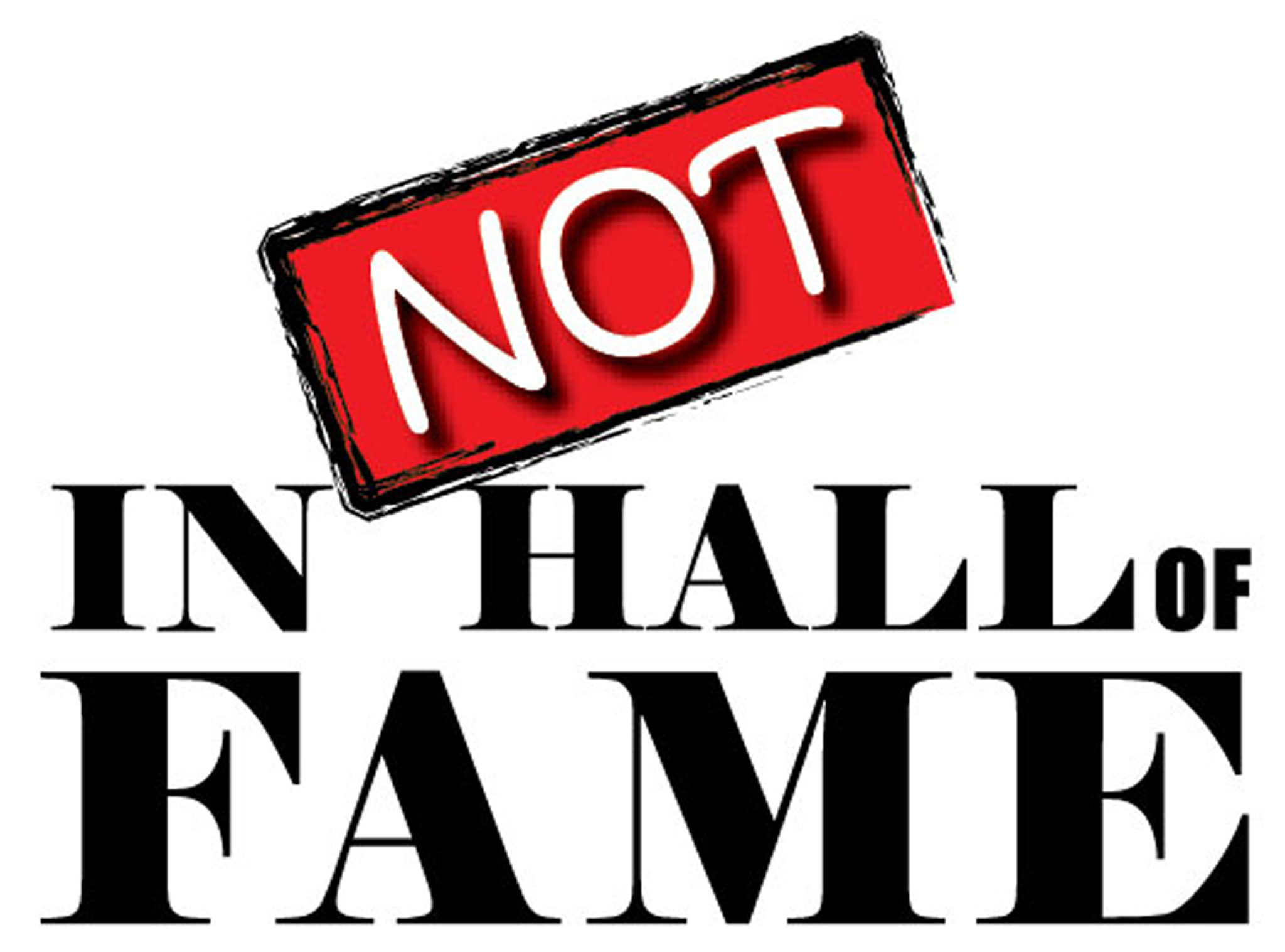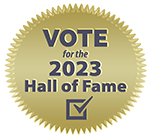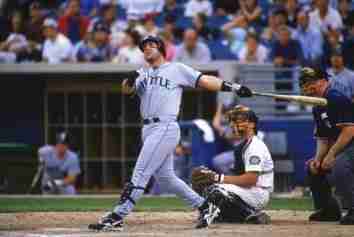The Mike Mussina Debate: 2015
Dec 27, 2014
Written by
Committee Chairman
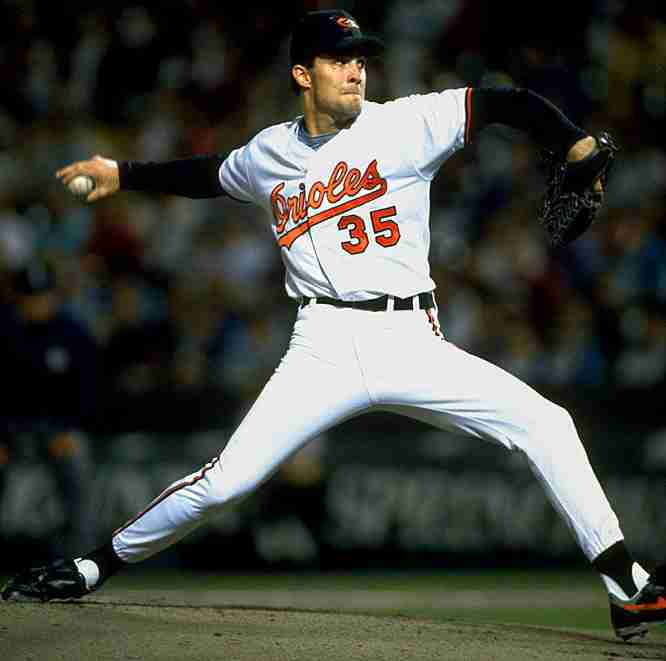
This is the fifteenth of our series where we here at Notinhalloffame.com, do what else? Debate the merit of twenty-four men on the most loaded Baseball Hall of Fame ballot in our lifetime.
Joining me, the site's Committee Chairman, in this debate are D.K. of the site's Phillies Archivist blog and Darryl Tahirali of the site's DDT's Pop Flies blog. This looks to be a very important part of our site, and we hope you will enjoy reading this as much as we enjoyed writing it.
Chairman: I went on record last year saying that the biggest shock to me was the paltry 20.3% he got on his first year of eligibility. I know he was “only” an All Star five times, but every stat points to this man as a Baseball Hall of Fame inductee. Personally, I think the biggest disaster that could happen is if Mike Mussina somehow fails in the ten years on the ballot to get into Cooperstown. It’s funny to me how someone who spent his entire career in the ballyhooed American League East, doesn’t have that cache name. We talked about the “Hall of Very Good”, and I think a lot of people want to automatically put Mussina there. He is better than that.
Darryl: I agree completely. In fact, three years ago, I wrote an article for the site in which I identified five "tough sell" Hall of Fame-caliber players, meaning that because of the ballot logjam they may get overlooked. Of course, one was Frank Thomas, and we saw how "overlooked" he was last year. On the other hand, the other four were Jeff Kent, Mike Piazza, Curt Schilling—and Mike Mussina. Moose may be a Bert Blyleven-type case in which the advanced stats will need to demonstrate how effective he was in tandem with his traditional stats. His 3.68 ERA may hurt a bit, but in that AL East he spent a lot of time with the Baltimore Orioles, which was a division doormat—and his FIP (fielding-independent ERA) is 3.57, meaning that he did a fair bit of heavy lifting and not his fielders. Mussina is better than a lot of pitchers already in the Hall—he won't cheapen the roster by any measure.
DK: Mussina’s not quite in the Pedro Martinez/Whitey Ford category in winning percentage, Whitey Ford, but who is? With his .638 winning% he’s closer to another current nominee, Randy Johnson and that’s plenty good enough company. Like Ford, who had just two 20-win seasons, which may surprise a lot of people, Mussina also is short in the 20 wins season category, winning 20 only once. He had a lot of Ford-like high win percentage seasons, however, going 18-5, 16-5, 19-9, 19-11, 18-7 17-8, 18-10 various years and other stellar seasons without reaching the 20 win mark.
I thought he might make a run for 300 wins, when he won 20 in 2008, but he was about 39 years and 10 months old when he go his 20th, for the only time in his career, in the Yankees 2008 season finale. Does that mean he didn’t have “the heart of a lion” to pursue 300, or that at nearly 40 he just considered himself done. Was he a good family man who just wanted to stay home after about 20 years on the road with his major and minor league teams or was he just a guy who wasn’t that driven by statistical goals. After all Al Kaline didn’t come back for one more season just because he was one home run below the 400 HR mark at the end of the 1974 season and Billy Pierce didn't cancel his retirement plans because he finished the 1964 season one strikeout below 2,000K - and no one holds that against them and doesn’t think they weren’t spectacular ballplayers.
Mussina’s 20% vote total last year was surprisingly low, but there have been others like Gary Carter who started small, but whose vote totals snowballed in the next few years afterwards towards eventual election by the BBWAA.
Chairman: So we all agree that Mussina is a Hall of Fame Pitcher, at least in our eyes. It is almost that he is in the wrong place at the wrong time with this vote; almost like his career in Baseball, as he was never on a championship Yankees team, which certainly would have helped; especially if he would have at least a signature post season performance, which he didn’t have.
I don’t know if you both saw the article that Buster Olney recently did where he stated he was abstaining from his vote to help a guy like Mike Mussina, a man he would vote for…if he had more than ten slots. Basically, he thinks by abstaining, he helps Mussina’s percentage, should others vote for him.
Now, I hate the idea of abstaining from a Hall of Fame vote, especially if this what some of the voters thinks it has come too but if anything illustrates the current logjam to get into Cooperstown better than this, I haven’t seen it.
D.K.: When I look at his career numbers I don’t find many numbers that are eye-popping, however, you see the picture of a very steady, consistent performer.
You might not think of him as a great strikeout pitcher, but Mussina didn’t fall too far short of being a 3,000 strikeout man, with 2813 Ks for his career. He never led the league in strikeouts but he topped 200Ks four seasons and he topped 170 Ks nine seasons. He was really consistent, but didn’t have the WOW FACTOR going for him of being the best pitcher in the majors at any time in his career.
With the absence of the WOW FACTOR, I think that Mussina fits the profile o someone who gets elected in their final one or two chances with the writers or fails short there and gets elected by the Veterans Committee.
Darryl: Chairman, I have not seen Buster Olney's article. Do you have a link or reference to it? I respect Olney's work and generally agree with his views. I admit that I am not a mathematician and would have to read his rationale, but I do not understand how abstaining from voting, and it sounds from your description that he is abstaining altogether because Mussina is not among his ten, would help Mussina. Again, I'm no math whiz, but it seems to me that the more votes cast for any player increases the chances for some candidates to be elected, and that removes them from the ballot and thus increases the chances for the remaining candidates in future years. Silly hypothetical: Say Olney planned to vote for Curt Schilling this year but abstains, and Schilling misses election by one vote. Olney's vote would have removed Schilling from the ballot by dint of election to the Hall--but now Schilling comes back on a future ballot, still siphoning support for Mussina. I don't get it.
DK, to your point about round numbers, we like them because they are convenient plateaus. To me, Mussina is a Hall of Famer without the 300 wins, and in any case, in his era of interventionist bullpens, 268 wins is 300 wins. Mussina had 43 "tough losses," losses in which he pitched a quality start (six or more innings pitched while allowing three or fewer earned runs), with 24 of those with Baltimore, and he had 40 wins lost (22 with Baltimore), games in which he had the lead when he left the game but his bullpen lost the lead and thus Mussina got a no-decision instead. (He had 113 of those altogether.) Somewhere in there are the 32 wins he needed for 300 games. Contrast that with Gus Wynn, who grimly hung on until his age-43 season to get to 300 wins in 1963, and his 1962 season, in which he fell one short of 300 wins, was really grim: 7-15 (.318), 4.46 ERA, 88 ERA+ (i.e., Wynn was a below-league-average pitcher). He returned in 1963, got his 300th win in his fourth start--on July 13, after not having pitched in his first game of the season until three weeks earlier--and pitched the minimum five innings necessary to be credited with a win. He started just one more game subsequently, getting a no-decision, while his 15 other appearances were as mop-up relief (he did earn one save). It was a desperate effort to reach a milestone, and watching Tim Wakefield labor to get to 200 wins a few years ago is probably a similar experience.
And now we get to the asinine premise of the Bernie Mac baseball movie
"Mr. 3000," in which Mac's character has three hits taken away from him by revisionist bookkeeping, and although he may have been a Hall of Famer at 3000 hits, he may not be at 2997 hits, and thus he suits up at age 47 to get back those three hits. Ugh! No! That's why I love Al Kaline's numbers. As you note, he did finish one home run shy of 400, and he was two doubles shy of 500 while his .297 batting average is three percentage points below .300. Now, had Kaline not played the 1974 season and thus passed the 3000-hit plateau with his 146 hits that season, would he have been a Hall of Famer with 2861 hits, 470 doubles, and 386 homers? Maybe not first-ballot, as he was in 1980 with more than 88 percent of the vote, but really?
Chairman: Darryl, here is the link to Olney’s reasoning. Anyway, for me Mussina gets on my ballot, but admittedly on the ten hole. I vote yes.
Darryl: Yes. Despite his paltry vote total last year, Mike Mussina is clean and is a no-doubt Hall of Famer. Get him off the ballot--and into Cooperstown.
D.K.: I can see why the writers asked that they be allowed to cast 12 votes instead of 10 this year. There’s simply too many good candidates right now. Even with an expanded ballot, however, Mussina still misses the cut. I ranked him #13. That’s a NO vote from me - not NO forever, but NO for this year with it’s crowded field.
The Mark McGwire Debate: 2015
Dec 26, 2014
Written by
Committee Chairman
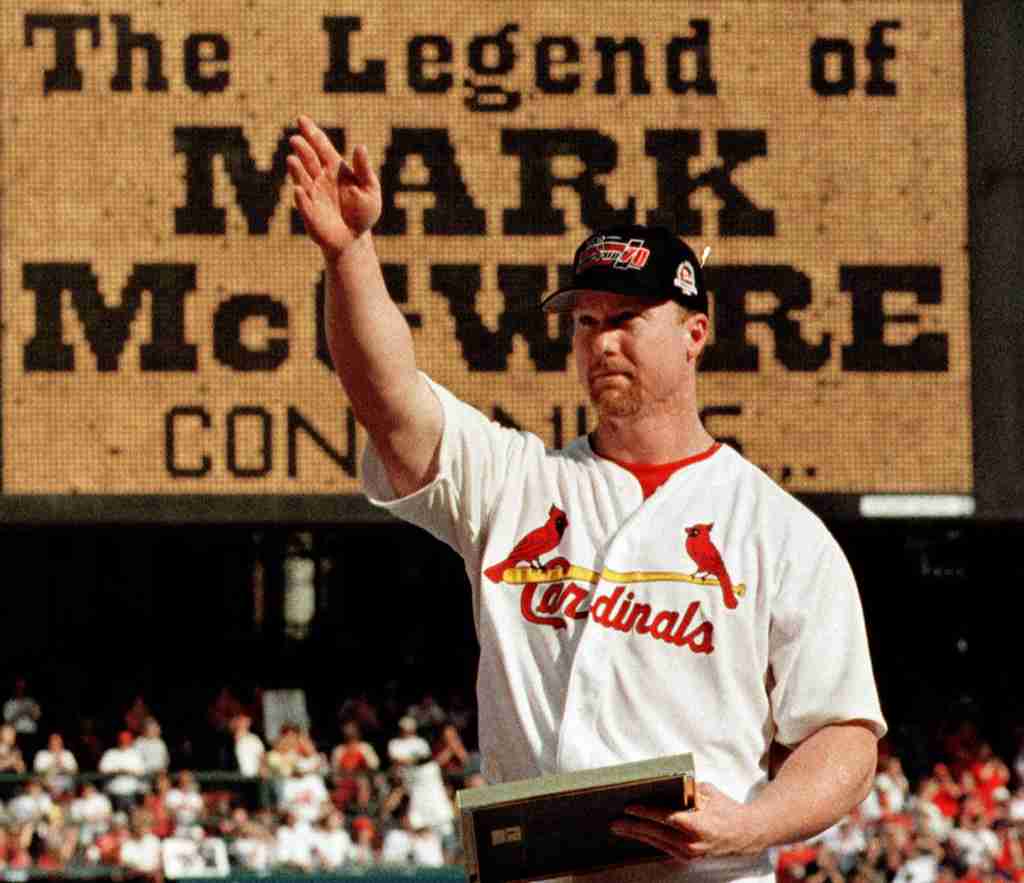
This is the fourteenth of our series where we here at Notinhalloffame.com, do what else? Debate the merit of twenty-four men on the most loaded Baseball Hall of Fame ballot in our lifetime.
Joining me, the site's Committee Chairman, in this debate are D.K. of the site's Phillies Archivist blog and Darryl Tahirali of the site's DDT's Pop Flies blog. This looks to be a very important part of our site, and we hope you will enjoy reading this as much as we enjoyed writing it.
Chairman: What, the PED discussion again? Actually, I am going to open with something a little different, as I have been a little surprised at just how much as his support has plummeted. This was the first “Steroids Guy” on the Ballot and here we are on year nine and the new ten year rule will kick him off in two years; and don’t think this isn’t by accident. Mark McGwire plummeted to eleven percent last year, but his fall shows me that contrition doesn’t mean anything to the writers. Nobody else apologized, and Big Mac has done pretty well for himself as a hitting coach in the Majors. So much for forgiveness.
Darryl: You and I differ on the intent of reducing the eligibility period. I think it is to reduce the logjam regardless of the perception of the player—Edgar Martinez, Tim Raines, and Alan Trammell are just as likely to fall off as the PEDs-suspected players. Mark McGwire was indeed the lightning rod, though, the first star with that PEDs association to hit the ballot. Regardless of what doping did to his performance, that performance is on the bubble—more peak dominance than longevity.
He was largely one-dimensional, a Three True Outcomes hitter—walk, strikeout, home run—but it was an awesome dimension. One thing that impresses me is that his on-base percentage of .394 is 131 points higher than his .263 batting average. He collected 1626 hits but walked 1317 times, and only 150 of those were intentional—but that's still 46th all-time. That's a feared hitter—and a selective one. Borderline, but he's like a Ralph Kiner: Essentially one tool, but it was a sledgehammer. Just barely a Hall of Famer—but I think at this point, a future Expansion Era Committee will have to debate that. And that is the ramification of the shortened eligibility period: Baseball is dumping responsibility for gatekeeping into the Hall on future committees.
D.K.: I think that a lot of the media that covered McGwire’s quest to surpass the single season total of Roger Maris back in 1998 felt like they’d been duped when it came out that McGwire wasn’t clean. These same writers are the ones who have withheld their vote for McGwire ever since he became eligible. Therefore I think McGwire’s chances for election are minimal.
Chairman: I stand by my conspiracy theories! We did not walk on the moon, there was another gunman and aliens built the pyramids in Egypt. Ok, bad jokes aside, we’ll agree to disagree on the motives, but you are right about equating McGwire to a one trick pony, though it was one equivalent in my eyes to Thornton Melon’s triple lindy (1% of future shares in the site to whoever gets that reference), but yes, taking away from PEDs it is a resume that puts you on the cusp of the Hall when looking at the bigger picture.
Saying that these future committees are going to be loaded with his generation’s “clean players”, so if McGwire and his friends are getting in, they have a better chance with the baseball writers, not with guys like Frank Thomas or Goose Gossage who have openly decried these guys shouldn’t be in, and could wind up on these future committees.
D.K.: The odd thing about Barry Bonds and McGwire is that they began using PEDs after they were already highly successful star players. Many have argued that if Bonds had left steroids alone he’d have made the Hall Of Fame anyway. McGwire wouldn’t have put up Hall Of Fame numbers, but he would probably have hit 400+ clean home runs and had a very good career. He reached the majors with a bang, smashing 49 home runs in his first full season of 1987 and topped 50 homers a few seasons later when he was still likely clean. He probably wouldn’t have made the HOF because he was only a .263 lifetime hitter and he struck out far too much.
Was it the Deadly Sin of pride that prompted Bonds and McGwire to chase records and increase their legacies that in the end became their downfalls.
Darryl: Chairman, you may be right that McGwire's best chance is with the writers and not a future veterans committee--that is an excellent point. The recent Hall of Famers will staff those future committees, and they are likely to keep their current perspectives. So, McGwire may in fact be his generation's Deacon White, not necessarily in terms of conduct, but that his great-grandkid may deliver the induction speech near the end of this century.
As for Thornton Melon, well . . . he just don't get no respect, does he?
Much like McGwire.
And as for a second shooter, don't get me started on the JFK assassination. The most plausible explanation to me would probably gobsmack a lot of people, but then I'd tell them to read David Lifton's "Best Evidence." (Hint: The "best evidence" is the body itself and what may have happened to it between Dallas and Bethesda, where the autopsy took place.)
Chairman: DDT, we have to sit down over beer one day and solve the problems of the world, and based on an earlier comment I owe you a small portion of the site. Personally, I do believe is a Hall of Famer, and I would have voted him in other years, but the glut of additional talent pushes him off if my ballot. I vote no.
Darryl: Chairman, I'll gladly take you up on that offer.
It's not so much the glut of additional talent--this year's ballot isn't any heavier than it has been in the past couple of years--but by now it is patently obvious even to me that anyone with tangible evidence or admission of PEDs usage is wearing a scarlet letter of "C" for Cheater and is not going to get 75 percent. So, this year my voting approach is primarily (although not exclusively) for those "clean" candidates who are with little dispute Hall of Famers. And with only 10 votes that means a mean triage.
So, no to Mark McGwire. Not this year.
D.K.: I’ve never been one to forgive and forget easily when I’ve been wronged.
(I still have a fist and a set of brass knuckles ready for an older bully who once sucker punched me when I was 13).
That said, when America watched the race between Mark McGwire and Sammy Sosa to topple Roger Maris’ season’s home run record of 61 homers in 1998 collectively we thought we were watching the greatest thing since Maris and Mickey Mantle were racing to beat Babe Ruth’s record of 60 HR nearly four decades earlier. The country thought it was watching history in the making; as it turned out we were only watching two frauds making fools out of the nation’s sports fans. The answer is a NO vote to McGwire this year and it might always be so.
The Fred McGriff Debate: 2015
Dec 26, 2014
Written by
Committee Chairman
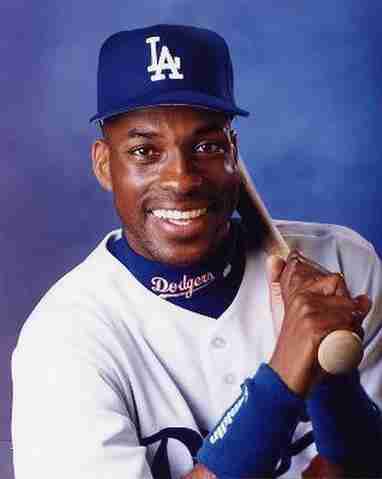
This is the thirteenth of our series where we here at Notinhalloffame.com, do what else? Debate the merit of twenty-four men on the most loaded Baseball Hall of Fame ballot in our lifetime.
Joining me, the site's Committee Chairman, in this debate are D.K. of the site's Phillies Archivist blog and Darryl Tahirali of the site's DDT's Pop Flies blog. This looks to be a very important part of our site, and we hope you will enjoy reading this as much as we enjoyed writing it.
Chairman: Prior to the PED controversy I kept thinking that Fred McGriff was going to wind up being the guy who would go down in history as the man who had the most Home Runs but wouldn’t wind up in the Hall of Fame. That has obviously changed, but I could easily change this to “player untainted with PEDs who has the most Home Runs not entering the Hall”. It was never that I once thought he wasn’t a very good player, or even at times great; but did the “Crime Dog” ever feel special?
He is entering year sixth on the ballot, coming off his all time low of 11.7%. Thirty years ago, wouldn’t this guy be in right away; or does his frequent movement make seem like a high priced journeyman?
Darryl: I do tend to go back and forth on Fred McGriff, but ultimately it is back to he falls just short. Crime Dog is on two cusps: One is that he started a decade before both the players and the numbers got big, so his year-to-year stats look strong but not eye-popping like the Steroids-Era players. Two is that both qualitatively and quantitatively, McGriff is on the cusp of greatness—just shy of 2500 hits, just shy of 500 home runs, and over 1500 RBI.
You may indeed be right: Turn McGriff's clock back 30 years, and his record looks like Willie McCovey's or Harmon Killebrew's. But that's not the case, and what really kills McGriff's chances is that by now the Hall is chock-full of power-hitting first basemen whose numbers are gaudier, and who had dominating peaks, which McGriff never had. He was excellent, but not elite, and you have to draw the line somewhere.
D.K.: Hall Of Fame standards are completely out of whack when a player like McGriff who put up such great numbers (as follows) receives so few votes. 493 home runs - 9 seasons of 30HR or more; 12 seasons of 25HR or more. 2 NL HR titles. 1550 Runs Batted In: 6 seasons of 100 or more RBI; 10 seasons of 90 or more RBI. Just under 2,500 career hits with a.285 batting average.
Man, what does a guy have to do to impress these writers?
Chairman: O.K., let’s play this game. How much does “fame” really matter? As a Jays fan going to the games, I never really thought “Hey, I’m going to watch Fred McGriff play today!” What imagination did he capture? Was he ever at any time considered the best at his position? I know I am arguing against stats, but I just want to throw that out there, and see just what being an icon in the sport means.
We just watched Gil Hodges fail to get into the Veterans Ballot, and while I am not saying that he has better stats than McGriff (he doesn’t), he was a guy who Dodgers fans paid to see. Does that mean anything, or should it? Maybe I am thinking of the romanticism of baseball and sports in general but shouldn’t that matter a little bit?
Unlike Larry Walker who is facing voting issues, McGriff doesn’t have a fan base as he played for three teams for five years and another five for another three combined, he has no real identity that makes any city want to rally around him. That might be why Hodges’ supporters are so passionate, and those of McGriff are non-existent.
D.K.: Playing all or most of one’s career in one city and for one team definitely has it’s advantages regarding the Hall of Fame and that goes for any sport. (I’ve often though that If linebacker Maxie Baughan hadn’t been included in a blockbuster multi-player deal in 1966 and been sent to the Los Angeles Rams and had stayed in Philadelphia his entire career he’d have been in the Pro Football Hall of Fame long ago. He only missed making the Pro Bowl one year in the early part of his career, otherwise he’s have made 10 straight pro Bowls and would have been perfect for the decade of the 1960s (Baughan made the NFL Pro Bowl for the seasons 1960-61 and 1963-69. His top years were split between Philly and LA and even unluckier than being traded from Philly was the fact that he was traded to a city that would lose its NFL franchise and that hasn’t had a team for the last 20 years - so no HOF backing comes from LA, and only some comes from Philly.
Nomadic players or players that test the free agency waters every few years do pay a price (at the gates of Cooperstown, or Canton, or Toronto, or Springfield) eventually. It is the voting writers’ job however, to see what value a player brings to his teams, no matter how often he changes uniforms and to not let a hometown push backing a player who spent all or most of his career with one team sway them unduly.
McGriff has some great numbers if you take the time to examine them. If I had a maximum of 10 choices like the writers do (and they are lobbying to be allowed to vote for 12 players instead of just 10), McGriff wouldn’t be in my first five choices, but he’d be among my ten somewhere.
Darryl: I'm not sure that Gil Hodges is a good comparison in terms of "fame" because he is an outlier--the Dodgers are a storied franchise, particularly the 1940s and 1950s Brooklyn version that is practically worshipped in Roger Kahn's book "The Boys of Summer." That mystique, as I suggested in my article on this year's Golden Era candidates, has probably inflated Hodges's perception--and, as I note, largely without justification. As for the "nomadic" aspect of McGriff's career, he played in the free-agency era, and the writers know that.
Look at Dave Winfield: I never thought of him as being the reigning star on his teams, and he played for six teams during his career. One of those, admittedly, was the New York Yankees, another "mystique" team, and Winfield did reach a Cooperstown milestone of 3000 hits, both of which were undoubtedly factors in his first-ballot election in 2001. I'm surprised that Atlanta isn't rallying around McGriff since three of his five All-Star appearances came while he was on the Braves. But has anyone considered whether his prolonged exposure through those Tom Emanski Baseball Fundamentals television commercials have ultimately soured his chances?
Chairman: You know I never saw those commercials before? Maybe that is the blessing (curse) of living in Canada. After doing research maybe that bright red hat is what should go on the bust; though it won’t happen on my ballot. I vote no.
Darryl: No.
D.K.: I ranked McGriff 10th and gave him my final YES vote. He’s at or near the top of the list when it comes to candidates on this ballot who have thus far been underappreciated by the writers.
The Don Mattingly Debate: 2015
Dec 26, 2014
Written by
Committee Chairman
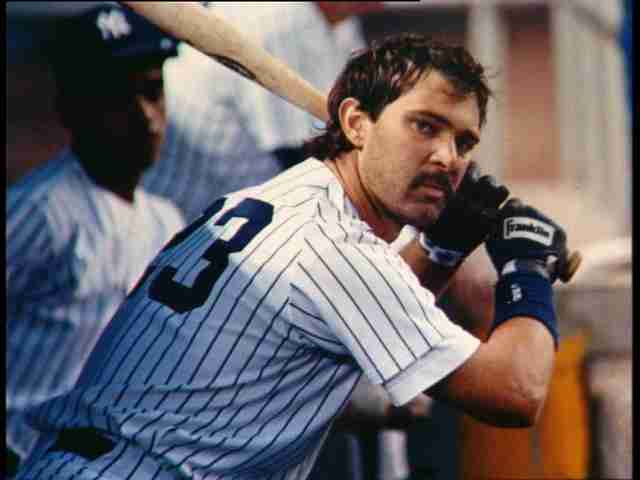
This is the twelfth of our series where we here at Notinhalloffame.com, do what else? Debate the merit of twenty-four men on the most loaded Baseball Hall of Fame ballot in our lifetime.
Joining me, the site's Committee Chairman, in this debate are D.K. of the site's Phillies Archivist blog and Darryl Tahirali of the site's DDT's Pop Flies blog. This looks to be a very important part of our site, and we hope you will enjoy reading this as much as we enjoyed writing it.
Chairman: Donnie Baseball. Mattingly is on his 15th year on the ballot, and I didn’t even realize this until I looked it up. Last year, Mattingly had 8.2 percent of the ballot, his lowest total ever. His highest was 28.2 percent, which was on his first year of eligibility. The second year was 20.3. I really like him, but here is a guy who might be this generation’s Steve Garvey; and I don’t mean because he pretended to be a really good guy in public. Basically, I am saying that sabremetrics is not his friend. With this loaded ballot, I could conceivably see him fall under fiver percent. Now I’m too lazy to look up if anybody ever fell below that 5 percent threshold on their final year, but that would have to be a first right?
Darryl: Well, the saber numbers are not his enemy—it's the counting numbers that are hurting him: Don Mattingly simply doesn't have the big career totals. Only six of his 14 seasons saw him play 150 or more games, and that is indicative of the injuries that dogged him. In the only season in which he played every game, 1986 in his age-25 year, Mattingly led the American League in hits, doubles, slugging percentage and total bases. He hit 31 home runs, drove in 113, and posted a .352/.394/.573 slash line. He had a six-year peak between 1984 and 1989, which is just a little short and he was not quite the dominant player during that time. That would compensate for the light counting numbers, but it never happened. Mattingly falls just short in both areas. And if he does fall below five percent this year, I think that would be more of an indicator of an overloaded ballot.
D.K.: This is his last year on the Writers’ Ballot Mattingly will be a Veterans Committee candidate two years from now in December 2016, for the HOF Class of 2017. If he is to reach the Hall Of Fame at all entrance to Cooperstown via the Vets Committee is his proper level of the Hall. Injuries prevented him from sustaining the type of dominant performance that adds up to a Writers Ballot HOFer, but I could see him getting in through the Vets.
Chairman: I think whatever metric you use, it comes down to a peak period that just wasn’t long enough and a period after that doesn’t measure up no matter how you slice it. I wonder though if he was on better Yankees teams, and whether we want to admit or not, Major League Baseball is more interesting when the Bronx Bombers are good, that if he played for a better team, that he would be closer to induction. Mattingly was the star of bad Yankees teams, but Rizzuto was what on great Yankees teams, maybe the fifth best player? Sorry…but I know that Darryl will understand when I say that Phil Rizzuto is my Percy Sledge. Holy Cow!
D.K.: There’s not much I could add to Darryl’s comment. He said it all – or at least most of it. Mattingly's Saber numbers or I guess you could call them his qualitative numbers are Hall Of Fame-like. It’s his quantitative numbers or counting numbers that weaken his case. His four or five year peak was not dominant enough over a long enough period of time to rate Hall of Fame enshrinement in the minds of most voters. He will be eligible for consideration by the Veterans Committee just two years from now in December 2016 on the Expansion Era committee ballot.
Mattingly has become part of a historical footnote. He is one of three players who had been through more than 10 BBWAA elections when they decided to shorten the number of years players can be voted in by the writers. Three players are being grandfathered in and will receive their full run of 15 years on the ballot as per the old rules. This will be Mattingly’s final year on the ballot, next year will be Alan Trammel’s final year on the writer’s ballot and Lee Smith will have his final vote in 2017. After Smith’s shot in 2017, the 15-year ballots rule will pass into history.
Darryl: At least Percy Sledge had an R&B hit called "Out of Left Field," so he's at least in the ballpark. I'm tempted to say that whether Mattingly was on a good or bad team doesn't, or shouldn't matter, but I don't know. Mattingly's record matches pretty closely to Kirby Puckett's in several ways. Both played at the same time, and even though Mattingly logged two more seasons, both played in nearly the same number of games although Puckett had about 100 more plate appearances and collected a season's worth more hits; thus, Puckett hit several points higher, .318 to Mattingly's .307, but otherwise their slash lines are about the same. Mattingly won a MVP award and was runner-up the following year; Puckett was top five three times. Puckett of course had postseasons heroics on his side as his Minnesota Twins won two World Series. Mattingly only ever saw one postseason series, in 1995, the AL Divisional Series against the Seattle Mariners famed for the "Edgar Martinez double" that won the fifth and deciding game. But we all but forget that Mattingly fairly raked in the series, knocking ten hits including four doubles and a home run for a .417 average while driving in six runs, so who knows what Mattingly could have done in more postseasons. Puckett is a marginal Hall of Famer, but he was worth about eight wins more in bWAR than was Mattingly, and that may be the real difference.
Chairman: I always like Mattingly…especially in his Simpsons cameo: “Mattingly, I thought I told you to trim those side sideburns!” Still, an appearance for Mr. Burns’ company softball team doesn’t get him on my ballot. I vote no.
Darryl: No.
D.K.: No.
The Pedro Martinez Debate: 2015
Dec 26, 2014
Written by
Committee Chairman
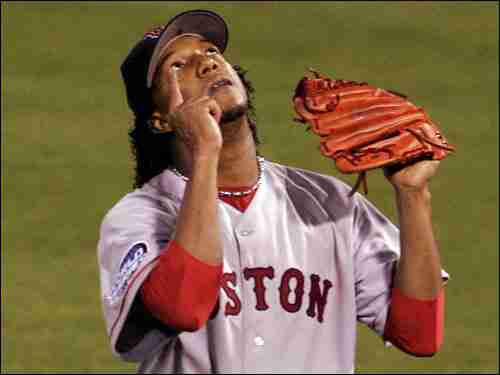
This is the eleventh of our series where we here at Notinhalloffame.com, do what else? Debate the merit of twenty-four men on the most loaded Baseball Hall of Fame ballot in our lifetime.
Joining me, the site's Committee Chairman, in this debate are D.K. of the site's Phillies Archivist blog and Darryl Tahirali of the site's DDT's Pop Flies blog. This looks to be a very important part of our site, and we hope you will enjoy reading this as much as we enjoyed writing it.
Chairman: We have another debut on this year’s ballot, and one that I think has an excellent shot at entering immediately. For the record, I love everything about Pedro Martinez, and for years he was my favorite (non Blue Jay) Pitcher. The only way I see somebody not voting for this guy, is for one of two reasons:
One, he is one of those writers who refuses to put anyone on the ballot because he thinks everyone was on PEDs, or can’t confirm who was and was not. Sadly, we have had some who openly do that.
Two, they are holding on to the archaic view that he only has 219 Wins. Gun to my head, I would build my team around Pedro over Randy Johnson, though I suspect the latter will get a higher percentage of the vote.
Darryl: I would build my team around Randy Johnson—he is more durable. In just under 200 more starts than Pedro Martinez, Johnson had 54 more complete games (he led the league in that category four times; Martinez, once), and pitched 37 shutouts, 20 more than Martinez, and two of Johnson's were no-hitters, one a perfect game. (Martinez once pitched nine hitless innings but gave up a hit in the 10th inning.) I mention this because as a Red Sox fan (they're number two behind the Giants), I still shudder at Pedro's staying in too long in Game Seven of the 2003 American League Championship Series against the Yankees, who tied the game against him and beat the Red Sox in extra innings to go to the World Series. Contrast that with Johnson's pitching heroics for the Arizona Diamondbacks in the 2001 World Series. Simply put, Randy Johnson is one of the most dominant pitchers ever to step on the mound.
Now, that said, Pedro Martinez is not too far behind. Any writer who thinks Pedro was on PEDs deserves to have his ballot privileges revoked permanently: Pedro was a skinny kid from the Dominican—he was a freaking David facing a host of steroids-fueled Goliaths, and like that Biblical stone-slinger Pedro mowed 'em down, one by one. In terms of run prevention, Pedro is better than the Big Unit: Martinez had two seasons with an ERA under 2.00, and Martinez had five seasons with an ERA+ over 200, and this was in the teeth of the Steroids Era; Johnson never matched either one of those accomplishments. In fact, Pedro is the only pitcher on the 2015 ballot, starter or reliever, with a sub-3.00 career ERA; his is 2.93. I've written an extensive article for this site that examines the usefulness—or lack thereof—in determining a pitcher's Hall of Fame worth, so I'll just echo agreement about their being archaic as a primary determinant. Pedro Martinez is one of the elite pitchers in the game's history—he is a first-ballot Hall of Famer without question.
D.K.: I’m still a little miffed that Pedro’s swan song was two World Series losses with the Phillies to the Yanks in 2009. The Yankees won the game by a two game margin and Pedro went 0-2 in the series ...you do the math...and Pedro can still call the Yankees ”his Daddy”.
As a Phillies fan I’ll give him my HOF vote grudgingly because you can’t ignore his stratospheric career winning percentage of .687 - second only to Whitey Ford (and Ford had a Yankees Dynasty backing him).
Chairman: So this looks like a unanimous opinion from us as to whether we think Pedro should be in the Hall. We all think he should, and believe it will be right away. Darryl, no issues from me for you picking Randy over Pedro, they are both giving our fictional teams bona fide aces either way.
Let’s throw this out. Is there any chance that the writer’s give a higher percentage to Martinez than Johnson? I vote no, but there are stranger things that have happened on Hall of Fame voting. Saying that, if he finishes in any other place than second, I would have read four different sources to believe it.
D.K.: Did I mention in round one that in addition to having one of the highest winning percentages of all time at .687 - and to simplify that it means Pedro went 11-5 for every 16 decisions throughout his career, he also is a 3,000 strikeout man. He’s in rarified company among pitchers, but as the luck of the draw has it, he also retired the same year as Randy Johnson and now they each become first-time HOF eligibles as well. Martinez and John Smoltz might suffer by the comparison to Johnson. While they are both in the 220 win range, Johnson won 303 games and while Smoltz and Pedro finished with about 3,100 strikeouts, Johnson dwarfs them again with nearly 4,900 Ks RJ also finished his career with an even 100 Complete Games, and that’s a rare accomplishment in this day and age.
Johnson also gets to be in those cool commercials where hot girls in tight shorts wash his car and mow and water his lawn while he relaxes in a lawn chair. I’ve already forgotten the product name because of those obvious curvy distractions - something to do with removing that grey from your goatee, I think. Well, that’s neither here not there I guess Pedro would be a lock in a normal year, but competing against Johnson, he might lose some votes by comparison, because for all but the last three or four years of his career, RJ was close to being “Superhuman”.
Darryl: Indeed, stranger things have happened on a Hall ballot--Ty Cobb polled more votes than did Babe Ruth on the inaugural 1936 ballot, and not only had Ruth just retired, and thus was fresh in writers' minds, but Ruth revolutionized the game and even then was considered to be the game's greatest superstar; furthermore, Ruth's colorful ways made him an American folk hero while Cobb remains one of the most disliked players of all time.
That said, I'd lay more money on North Korea's getting elected to the United Nations' Security Council than on Pedro Martinez garnering more votes than Randy Johnson this year. But who knows? Maybe that new movie with Seth Rogen and James Franco will help North Korea . . .
Chairman: This is a no-brainer for me. I am all in Pedro and am openly cheering for him to be a first ballot inductee. I vote Yes.
Darryl: Yes.
D.K.: I’m using all my 10 votes. I ranked Pedro 6th. - That means it’s a Yes vote for me.
The Edgar Martinez Debate: 2015
Dec 25, 2014
Written by
Committee Chairman
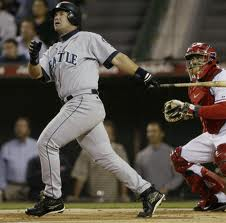
This is the tenth of our series where we here at Notinhalloffame.com, do what else? Debate the merit of twenty-four men on the most loaded Baseball Hall of Fame ballot in our lifetime.
Joining me, the site's Committee Chairman, in this debate are D.K. of the site's Phillies Archivist blog and Darryl Tahirali of the site's DDT's Pop Flies blog. This looks to be a very important part of our site, and we hope you will enjoy reading this as much as we enjoyed writing it.
Chairman: Ahhh…the Designated Hitter. For my entire life, and let’s just state that I am no longer a young man, the DH has been part of baseball fandom and growing up in an American League city (Toronto), I don’t know it any other way. Yet, here we are, with the DH well off the place where he could date a late 20 year old, and he is still judged as too young to be relevant.
Gentlemen, after all of this time do we have a case where the Baseball Writers don’t respect a part of the game that has been a fixture for more than four decades? I have to think that, because if Edgar Martinez, who has to be considered the greatest DH of all time can’t get to 50 percent of the vote, will anyone who forgoes a glove for the bulk of their career ever have a shot?
Darryl: Call me a Polyanna, but I don't think this is a case of outright antipathy toward the DH. Granted, it has taken time to acknowledge the position, and it has been incremental: Paul Molitor was elected, and he played about 44 percent of his games at DH. Frank Thomas went in, and he played about 57 percent at DH. Edgar Martinez played 70 percent at DH, and that is significant: He played about four seasons' worth at third base—and he was a better third baseman than Thomas was a first baseman, and third is a tougher position. But both Molitor and Thomas hit Hall of Fame milestones, the former with 3000 hits, and the latter with 500 home runs. Martinez has terrific qualitative numbers but he doesn't have those counting numbers. By now I think Martinez's bigger problem is the logjam on the ballot, which is affecting almost every candidate—but his time is running out.
D.K.: If I remember correctly Martinez was a decent fielding third baseman before injuries limited him to DH duties. He then set the standards for all DHs with ten .300 seasons, five 100 RBI seasons, over 300 home runs and a .312 career batting average. If elected, Martinez will have played a highest percentage of games at DH than anyone in Hall Of Fame history (almost 70%), surpassing Paul Molitor who DHed in nearly 44% of his career games. Like another of this year’s candidates, Craig Biggio, Martinez was something of a ”Doubles Machine” with 514 doubles lifetime, reaching 50 doubles in a season twice and leading the AL in that category twice also.
I think he’s deserving... it all depends on how open-minded the writers are to having the first real full-time DH in the HOF.
Chairman: Those are great points about Thomas and Molitor, though and based on the percentages you gave about the three (Thomas, Molitor and Martinez), the perception about Edgar as “only” being a DH, isn’t that far off the mark. I do think there is some bias towards the position, though the stiff competition he faces does him no favors.
I think we all agree that Martinez has some serious HOF qualifications, but isn’t a must for any of us. Let me change the question here: With all the great players who were his teammates (A-Rod, Griffey, Randy Johnson) who are all Hall of Fame locks (or would have been had he not been caught lying about PEDs multiple times, and yes A-Rod I’m looking at you) is Edgar Martinez the greatest Seattle Mariner of all time? I’m not saying that he is the best player to ever wear the uniform, but the greatest Mariner, if you catch my meaning.
D.K.: The Hall Of Fame really hasn’t reached the age of the dominant one inning closer. When it does, however, I’d expect Trevor Hoffman to be the first serious contender for the Hall. It’s a reflection of how the game has evolved that the only relievers in the HOF now are those who were expected to go a few innings, if necessary (Wilhelm, Fingers, Gossage, Sutter).
I don’t expect there to be any controversy regarding their possible place in the HOF (once they become eligible) because Billy Wagner, Hoffman and Mariano Rivera were only expected to pitch the ninth inning unlike relievers of previous eras.
However there is quite a fuss over Designated Hitters, players who hit only and don’t field a position, unlike players of previous eras who were both expected to excel at the plate and in the field. - Designated hitters. Edgar Martinez and other DHs didn’t rewrite the rulebook in 1973 that allowed the Designated Hitter in the American League. They merely tried to fulfill that DH role as well as humanly possible and Martinez filled that role better than anyone in the 40 plus years of the DH rule’s existence. I’m leaning strongly towards giving Edgar my vote.
Darryl: Interestingly, the Wikipedia page for Baseball Hall of Fame inductees lists Frank Thomas's primary position as DH (Paul Molitor's is third base). Nothing to take to the bank except that it is being recognized now. And of course the annual award for the best DH has been re-named for Edgar Martinez, who probably best exemplifies the position, but how ironic if he is never elected to the Hall.
However, to your question, Chairman, I'm not sure that Martinez is even the greatest Mariner. Randy Johnson first gained fame in Seattle, but his greatest fame was with the Arizona Diamondbacks. Between the historic contract Alex Rodriguez signed with the Texas Rangers and then his move to the New York Yankees, many people may forget that he started as a Mariner. However, I think that Ken Griffey, Jr., is and will continue to be regarded as the greatest Mariner: The Kid notched his four home run titles and his only MVP award in Seattle. Mariners fans may consider Martinez the hometown favorite because he spent his entire career with Seattle, but I think he will continued to be overshadowed by Griffey, and when Griffey is elected in a couple of years, he will in all likelihood have the Mariners' cap on his plaque--and it is very possible that Martinez will still not have been elected even then.
Chairman: In previous years I would have had him on my ballot, I have to push him off of this one, again due to the logjam. Personally, I think he is a Hall of Famer, but since I can’t vote for twelve, he receives an apologetic no from me.
D.K.: Since the designated hitter has been part of the game in the
American League for over 40 years, I feel that sooner or later they’ll have to start recognizing DHs who really distinguish themselves and separate themselves from the pack. My vote is for Sooner - and thus it’s a YES vote for EDGAR. He made my top 10 at #9 so he gets my vote.
Darryl: No. Not this year.
The Jeff Kent Debate: 2015
Dec 24, 2014
Written by
Committee Chairman
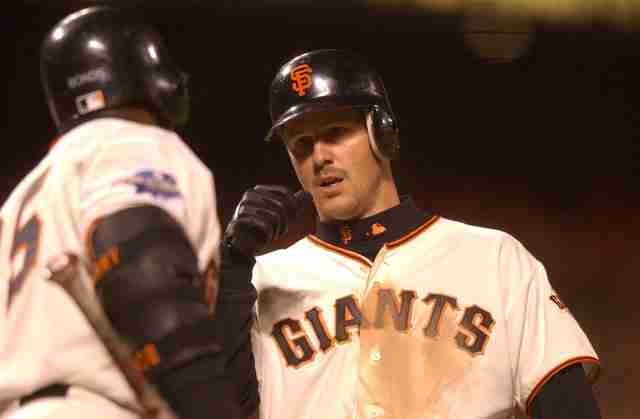
This is the ninth of our series where we here at Notinhalloffame.com, do what else? Debate the merit of twenty-four men on the most loaded Baseball Hall of Fame ballot in our lifetime.
Joining me, the site's Committee Chairman, in this debate are D.K. of the site's Phillies Archivist blog and Darryl Tahirali of the site's DDT's Pop Flies blog. This looks to be a very important part of our site, and we hope you will enjoy reading this as much as we enjoyed writing it.
Chairman: You know guys, even though this is what I do most of my life, I honestly didn’t remember that Jeff Kent made the first year, and especially didn’t remember that he was at slightly over 15 percent last year. Why is that, I wonder? This is a former MVP, a man with healthy numbers, yet here I see a Survivor reject who will put up Don Mattingly voting numbers without the Don Mattingly respect. Do we have someone who was a little overrated to get to this spot, or is the first perception I have accurate?
Darryl: No, I don't think Jeff Kent is overrated, but full disclosure: I'm a lifelong Giants fan, so I have to keep my bias in check. That said, I think Kent is underrated and certainly overshadowed by Barry Bonds, and in that case he probably didn't get a lot of respect—not helped by his own somewhat aloof attitude, but this isn't the Hall of Nice Guys. Besides, we know where they finish. Speaking of finishing, Kent finished 25th in doubles with 560 (tied with Hall of Famer Eddie Murray), 51st in RBI with 1518 (nine more than Mickey Mantle), and even if his 377 home runs are 70th all-time, his 351 hit as a second baseman are the most-ever by anyone at that position. And Kent was at one of the strength positions defensively—2034 games at second base—and even if he wasn't a Gold Glover, he didn't stink: He was about league-average in the field, and it was his bat that mattered. All this said, I think Kent will hang onto the ballot for a few years, but he will be overshadowed and passed over, and a future Expansion Era Committee will have to decide whether he goes in.
D.K.: He has more home runs than any second baseman in MLB history, but what does that really mean? Not known for a winning personality and a player that was known to feud with teammates and writers, I wonder if he is in for a Jim Rice-like candidacy. Which is to say that due to writers who hold grudges against him and refuse to give him their vote for as long as possible - Kent might one day be a Veterans Committee candidate, where a panel of more impartial voters may one day vote him in.
Chairman: So gang, what are we saying here? It seems like we are basically saying we don’t really care if Kent hangs on to the ballot or drops off of it, and if another generation (Veteran’s Committee) wants to look at him, so be it. Maybe that is really what we have here in Kent, is a guy who was damned good, has better stats than you think, but nobody will shed a tear if he doesn’t get in. Hell, I doubt, if Jeff himself gives it any thought! Darryl, as a Giants fan, have you heard an interview where he gives an opinion the subject?
D.K.: Not the most likeable personality, Kent was even an early departure on the TV show “Survivor” - “It’s time to go Jeff - The Tribe has spoken”, but that’s not what we’re really here to judge.
Kent played a yeoman’s 2,034 games at second base and had nearly 2,500 hits.
His 377 home runs is in a class of it’s own for second baseman - and he’s tied on the all-time list in home runs with big bopper, first baseman, Norm Cash. A .290 hitting second baseman with first baseman/outfielder-like power, Kent’s candidacy is starting to grow on me.
I started out in round 1 against his candidacy, but now I can’t help but admit that his numbers are swaying me. It’s going to be an election day decision as to whether he gets my vote - I mean, seriously - It might come down right to the wire!
Darryl: First, I wouldn't say that I don't care whether Kent hangs onto the ballot or falls off, but I do think the latter is more likely in this logjam environment. We will need to see whether his initial 15 percent last year was a first-year spike or is an indication of a groundswell of support, but in either case he will most likely languish in the same range as Fred McGriff or Don Mattingly in this ballot environment. As for knowing his opinion on the Hall, I do not know of any indication Kent has given, but quite honestly I don't follow celebrity personality in any field so I'm the wrong person to ask. As for his Hall of Fame credentials, as a right-handed power-hitting second baseman, Jeff Kent is below Rogers Hornsby--but who isn't?--roughly equal to Ryne Sandberg, and ahead of Joe Gordon, and all three are in the Hall, so I don't think there is any question that he belongs.
Chairman: I will admit that I am not as sold on Jeff Kent as the two of you, I have to say that you have pushed me more on to his cause than I had been previously. Still, I am voting no, but that is far more due to a crowded ballot than anything else. I want to see him stay on so that we can debate this one again.
D.K.: After a slow start Jeff Kent’s candidacy grew on me, particularly since his numbers are great for his position, second baseman. He’s one of my two near misses - the other being Larry Walker. Call him 11A and Walker 11B in my rankings. He’d have gotten my vote if the BBWAA writers had been able to push through their proposal to increase the maximum votes from each writer’s ballot to 12 - A reluctant no for 2015, but I’d vote for him if this logjam of incredible talent ever eases up.
Darryl: No. Not this year.
The Randy Johnson Debate: 2015
Dec 23, 2014
Written by
Committee Chairman
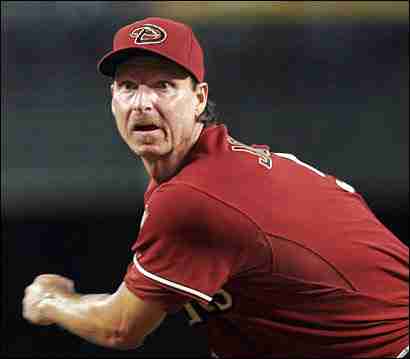
This is the eighth of our series where we here at Notinhalloffame.com, do what else? Debate the merit of twenty-four men on the most loaded Baseball Hall of Fame ballot in our lifetime.
Joining me, the site's Committee Chairman, in this debate are D.K. of the site's Phillies Archivist blog and Darryl Tahirali of the site's DDT's Pop Flies blog. This looks to be a very important part of our site, and we hope you will enjoy reading this as much as we enjoyed writing it.
Chairman: We have Randy Johnson up next; making his Baseball Hall of Fame debut on the ballot; this year’s Greg Maddux. I think you both know where I am going with this one, as I can’t see how he doesn’t follow Maddux as a first ballot inductee. The stats are there, the championships are there, and the awards are there. I think the only thing we are debating is what percentage he gets in at. I’ll put the opening number at 91. How far off do you think that mark is?
Darryl: I'm more bullish than you are—even with Pedro Martinez also making his debut this year, I think the vote total for Randy Johnson is going to be north of 95 percent. Just in terms of sheer dominance, the Big Unit recalls another Johnson, Walter "the Big Train," as well as Sandy Koufax and Nolan Ryan. Yes, his record speaks for itself—and we may never see another 300-game winner in our lifetimes—but two peripheral stats stand out to me: One, he struck out 10.6 batters per nine innings pitched—that's the best in Major League history. Two, his FIP (fielding-independent pitching, factoring only those elements over which a pitcher has total control: strikeouts, walks, hits by pitch, and home runs) is 3.19, which is better than his 3.29 ERA, meaning that he was better at run prevention without eight other fielders on the field with him. The only mystery to me is what the reasons why the few who won't vote for Randy Johnson are going to be.
D.K.: 303 wins a winning percentage of about .650 and the second most strikeouts in baseball history with 4875Ks (only pitcher to come within 1,000 strikeouts of Nolan Ryan). He’s the most “sure thing” candidate to get elected on the first year of eligibility that I've seen in several years.
Chairman: Fair enough. All three of us are in complete agreement that Johnson should become a first ballot Baseball Hall of Fame inductee right away. Maybe, I am looking at a low percentage because I don’t think Cooperstown will do the right thing.
That’s on me, but let me bump up a bit and revise my guess to 94.1% of the vote. Are any of us willing to take the over or under on that? Also, let’s openly ask…will that fabulous mullet be on the Cooperstown bust? I demand a riot in upstate New York if that doesn’t occur!
D.K.: Maybe Johnson gave a writer or two a dirty look or his famed 1,000 yard
stare, after reading their reportage on one of Johnson’s few not-so-stellar outings and those reporters have held grudges all these years. That ‘s the only circumstance that I can see where RJ’s support won’t be unanimous.
Darryl: Greg Maddux got 97.2 percent last year on an overstuffed ballot. Randy Johnson will get 98.6 percent. And regardless of which hat goes on the plaque, there indeed had better be a mullet underneath it.
Chairman: The unanimous vote will never occur, though I would like to hear arguments from the writers who don’t as to why; and it better be a hell of lot better than a protest against the era vote, which we have seen before. Saying that I am an emphatic yes on this one.
D.K.: He’s about as close to a unanimous candidate among the near-600 writers who will cast their votes as you will find. I ranked him as this election’s #1 candidate (by a wide margin over runner-up Craig Biggio). - YES to RJ and there was never a doubt.
Darryl: Yes. Although I know a family of a dead dove who would argue otherwise. Can't believe we haven't mentioned the pulverized bird yet. That's like talking about Ozzy Osbourne and not bringing up bats.
The Brian Giles Debate: 2015
Dec 23, 2014
Written by
Committee Chairman
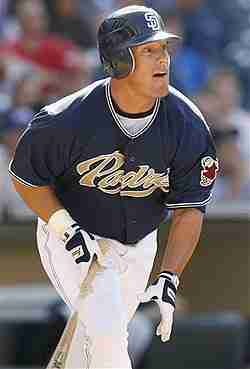
This is the seventh of our series where we here at Notinhalloffame.com, do what else? Debate the merit of twenty-four men on the most loaded Baseball Hall of Fame ballot in our lifetime.
Joining me, the site's Committee Chairman, in this debate are D.K. of the site's Phillies Archivist blog and Darryl Tahirali of the site's DDT's Pop Flies blog. This looks to be a very important part of our site, and we hope you will enjoy reading this as much as we enjoyed writing it.
Chairman: Brian Giles is another one of those guys that when I think of the Baseball Hall of Fame I would ever equate with. Hell, I almost didn’t even include him I the 24 we were going to discuss. The first thing I thought of was here is a guy who was only an All Star twice (and with bad Pittsburgh teams) yet a quick look at his career stats reminded me that he was a lot better than I remembered. Sure he was saddled with some pretty mediocre teams, but a .400 career OBP with some decent power numbers tells me that he wasn’t that far. Hell, if he was half decent defensively he could have been this generations Bobby Grich, who was also “one and done” like I expect Giles to be.
Darryl: "Half-decent defensively" underlines why the comparison between Brian Giles and Bobby Grich won't work: Grich was an excellent middle infielder defensively who was a potent offensive force at a time when middle infielders didn't hit. Giles was a corner outfielder who was expected to show good offense, and he did—surprisingly good, as that .291/.400/.502 slash line shows—but, yes, he was a defensive liability in right field. Giles joins a host of very good outfielders we've seen come onto the ballot in the last few years—Moises Alou, Steve Finley, Luis Gonzalez, Shawn Green—but in terms of career numbers or peak dominance, Brian Giles looks more like Garret Anderson than any of those four. I do like that Giles walked 348 more times than he struck out, unusual in this strikeout-happy era, but that's hardly a blue chip to take to the Hall.
D.K.: Giles had a four year peak between 1999 and 2002 where he averaged 37 home runs per year, but that will be viewed as too brief a period of excellence or dominance. His career totals of 287 HR and 1,897 hits are indicative of a player who was pretty good, but not great - and not a Hall Of Famer.
Chairman: Basically, are saying that we have a decent player who certainly had a good career but debating his merits seems a little pointless, especially on this ballot. Are we agreed on that assessment?
D.K.: Agreed, Chairman. Giles was a well-above average hitter, hitting a robust
.291 for his career, but not much a defender. I had hoped during his career hat he would at least distinguish himself by reaching the 300 home runs and 2,000 hits milestones, but from a combination of aging and injuries he failed to do even that. Giles was a pretty good ballplayer, especially at the plate, but not a Hall Of Famer.
Darryl: Agreed. Giles was an excellent player, not an elite one. And I don't think he would merit much attention on any ballot in previous years or decades.
Chairman: With all due respect to Brian Giles, who had a solid career, this is my easiest no. In retrospect I let decent numbers cloud me into thinking he may have worth discussing.
D.K.: I really liked Giles and he did have those four years of 35+ home runs, but I can’t vote for him. - NO
Darryl: No.
The Nomar Garciaparra Debate: 2015
Dec 23, 2014
Written by
Committee Chairman
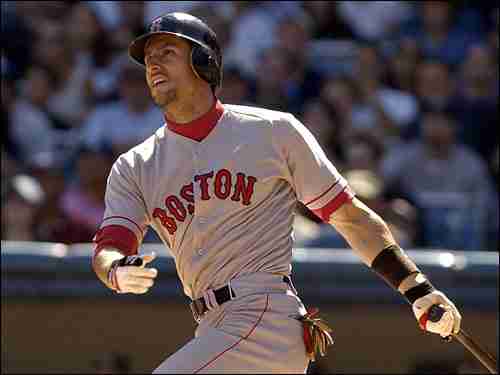
This is the sixth of our series where we here at Notinhalloffame.com, do what else? Debate the merit of twenty-four men on the most loaded Baseball Hall of Fame ballot in our lifetime.
Joining me, the site's Committee Chairman, in this debate are D.K. of the site's Phillies Archivist blog and Darryl Tahirali of the site's DDT's Pop Flies blog. This looks to be a very important part of our site, and we hope you will enjoy reading this as much as we enjoyed writing it.
Chairman: Ah…”Nomah”. I don’t know about the two of you but when I think of Garciaparra in relation to the Baseball Hall of Fame all I can think is that is this was 2003, the three of us would have said in unison (or so I think we would) that this guy was a future Baseball Hall of Famer, and probably on way to being a lock. It didn’t quite work out that way did it, and now when I think of Garciaparra, I think of Jimmy Fallon’s skit on Saturday Night Live, where he and Rachel Dratch played Boston fans. Not exactly the first thought you should come up when discussing a Hall of Famer is it?
Darryl: Nomar Garciaparra demonstrates just how amazingly difficult it is to become a Hall of Famer: A player must have both career longevity and an exceptional peak period—and not simply be a reliable compiler. Garciaparra roared out of the gate, and in 2003 we would have indeed declared him to be on the fast track for the Hall. His first half was Hall-worthy, but the drop-off from 2004 on killed his chances, and that is the sad fact about baseball immortality. A few players have made the Hall based on peak period alone, but those players—Sandy Koufax, Ralph Kiner—so dominated their periods that they overwhelmed the competition, and although Koufax was first-ballot, Kiner got in on the writers' vote by the skin of his teeth, literally—one vote over the minimum in his final year of eligibility. Garciaparra's early peak was not as dominant, although that may say more about the high talent compression in Garciaparra's time than his relative lack of absolute dominance—there are more good players now than in Koufax's or Kiner's time.
D.K.: Hit .313 lifetime, but he won’t get much support for the HOF. At one time he was considered on a par with Jeter and A-Rod among major league shortstops. Then a ton of injuries befell him and shortened his career. Unfortunately, the HOF doesn’t reward players on their potential or what they might have accomplished if they had stayed injury-free.
Chairman: So does this mean that mean that the three of us can agree that Nomar is one and done? Seriously, even with the most loaded ballot in recent memory would it matter? My question to the both of you is would Garciaparra make it to a second ballot if it were a less loaded list? Personally, I don’t think so, but I want to hear your thoughts on it.
Darryl: Yes, I do think Garciaparra would make it to subsequent ballots without so much competition, and he may in fact do just that this year anyway: Back-to-back batting titles and that .313 career batting average carry some weight. I'm reminded a little of Kirby Puckett here, who was voted into the Hall on his first ballot with only a 12-year career, although how much of that was sympathy for his glaucoma we may never know, and whether Puckett could have done that on this ballot is also uncertain, but I highly doubt it. So, although he won't get in, I'm not so sure that Nomar will be a one-and-done even on this ballot. On the other hand, I had Kenny Lofton pegged as a Hall of
Famer two years ago--and I still think he is--but he did not last past his first ballot.
D.K.: I think some writers will remember Nomar’s batting titles and his peak injury-free years and that will result in Nomar receiving 15 to 20 % of the vote. He’s not a “One and done”, but his position will be precarious and he may not make the full run of ten years on the ballot before dropping out with less than 5% some year.
Chairman: You are both more optimistic than I, as unless there are a lot more Boston sportswriters who have a say, I don’t think he gets off the maiden voyage. He wouldn’t on my ballot, as I vote no.
Darryl: No to No-mah.
D.K.: I vote No too, but I’m not crying for him. He married Mia Hamm. The same Mia Hamm. Nomar isn’t a HOFer but he does have Mia for consolation.
